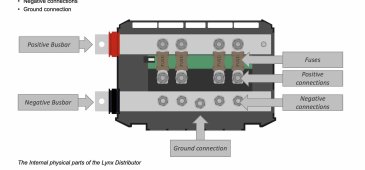AlaskanNoob
Solar Enthusiast
- Joined
- Feb 20, 2021
- Messages
- 967
Apparently the cables supplied by Pylontech for their batteries are only rated for about 100 amp and the terminal connectors for about 130amp.
I'm going to have 400 amp going into the batteries from the Lynx Distributors for charging (2 SCCs that put out 200 amp each).
Apparently a solution to the Pylontech cable limit of 100 amps is "doubling up" the wires. I'm trying to figure out how to double up the wires.
Would that mean:
AB to 3
EF to 4
GH to 5
CD to 6
 Would that work? Since the power from the Lynx will split between two stacks of four batteries, I would assume that would be 200 amp going into each stack of 4 batteries. So if I double the 100 amp wires, I think I'd be good but I just want to confirm.
Would that work? Since the power from the Lynx will split between two stacks of four batteries, I would assume that would be 200 amp going into each stack of 4 batteries. So if I double the 100 amp wires, I think I'd be good but I just want to confirm.
If so, then I'd have the two inverters wired into 2 and 7, and the charge controllers wired into 1 and 8. From looking at the Victron Wiring guide, it seems to suggest wiring up the batteries into the middle of the Lynx. I guess for more even power distribution.
Many thanks for the assist!
I'm going to have 400 amp going into the batteries from the Lynx Distributors for charging (2 SCCs that put out 200 amp each).
Apparently a solution to the Pylontech cable limit of 100 amps is "doubling up" the wires. I'm trying to figure out how to double up the wires.
Would that mean:
AB to 3
EF to 4
GH to 5
CD to 6
 Would that work? Since the power from the Lynx will split between two stacks of four batteries, I would assume that would be 200 amp going into each stack of 4 batteries. So if I double the 100 amp wires, I think I'd be good but I just want to confirm.
Would that work? Since the power from the Lynx will split between two stacks of four batteries, I would assume that would be 200 amp going into each stack of 4 batteries. So if I double the 100 amp wires, I think I'd be good but I just want to confirm.If so, then I'd have the two inverters wired into 2 and 7, and the charge controllers wired into 1 and 8. From looking at the Victron Wiring guide, it seems to suggest wiring up the batteries into the middle of the Lynx. I guess for more even power distribution.
Many thanks for the assist!





